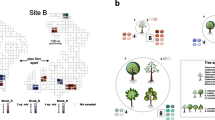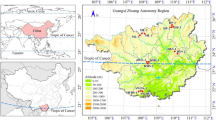Abstract
Plant community structure responds strongly to anthropogenic disturbances, which greatly influence community stability. The changes in community structure, aboveground biomass (AGB), biodiversity and community stability associated with different management practices were studied with a three-year field investigation in a temperate steppe of Inner Mongolia, China. The species richness, Shannon-Wiener index, evenness, plant functional type abundance, AGB, temporal community stability, summed covariance, scaling coefficient and dominant species stability were compared among areas subjected to long-term reservation (R), long-term grazing (G), mowing since enclosure in 2008 (M) and grazing enclosure since 2008 (E). Site R had higher perennial grass abundance and lower species richness than sites G, M and E, although the AGB was not significantly different among the four sites. The species structure varied from a single dominant species at site R to multiple dominant species at sites G, M and E. The long-term reservation grassland had lower biodiversity but higher stability, whereas the enclosed grassland with/without mowing had higher biodiversity but lower stability. Different stability mechanisms, such as the compensatory dynamics, mean-variance scaling and dominant species stability were examined. Results showed that community stability was most closely related to the relative stability of the dominant species, which supports the biomass ratio hypothesis proposed by Grime.
Similar content being viewed by others
References
Auerswald K, Wittmer M H O M, Bai Y F, et al. 2012. C4 abundance in an Inner Mongolia grassland system is driven by temperature-moisture interaction, not grazing pressure. Basic and Applied Ecology, 13(1): 67–75.
Bai Y F, Han X G, Wu J G, et al. 2004. Ecosystem stability and compensatory effects in the Inner Mongolia grassland. Nature, 431(7005): 181–184.
Bai Y F, Wu J G, **ng Q, et al. 2008. Primary production and rain use efficiency across a precipitation gradient on the Mongolia plateau. Ecology, 89(8): 2140–2153.
Bai Y F, Wu J G, Clark C M, et al. 2012. Grazing alters ecosystem functioning and C:N:P stoichiometry of grasslands along a regional precipitation gradient. Journal of Applied Ecology, 49(6): 1204–1215.
Box G E P, Hunter W G, Hunter J S. 1978. Statistics for Experimenters. Hoboken: John Wiley & Sons.
Carpenter S R. 1989. Replication and treatment strength in whole-lake experiments. Ecology, 70(2): 453–463.
Carpenter S R. 1990. Large-scale perturbations: opportunities for innovation. Ecology, 71(6): 2038–2043.
Collins S L, Knapp A K, Briggs J M, et al. 1998. Modulation of diversity by grazing and mowing in native tallgrass prairie. Science, 280(5364): 745–747.
Conant R T, Paustian K, Elliott E T. 2001. Grassland management and conversion into grassland: effects on soil carbon. Ecological Applications, 11(2): 343–355.
Cottenie K, De Meester L. 2003. Comment to Oksanen (2001): reconciling Oksanen (2001) and Hurlbert (1984). Oikos, 100(2): 394–396.
Cottingham K L, Brown B L, Lennon J T. 2001. Biodiversity may regulate the temporal variability of ecological systems. Ecology Letters, 4(1): 72–85.
Díaz S, Lavorel S, Mcintyre S et al. 2007. Plant trait responses to grazing–a global synthesis. Global Change Biology, 13(2): 313–341.
Doak D F, Bigger D, Harding E K, et al. 1998. The statistical inevitability of stability-diversity relationships in community ecology. The American Naturalist, 151(3): 264–276.
Fischer M, Bossdorf O, Gockel S, et al. 2010. Implementing large-scale and long-term functional biodiversity research: The biodiversity exploratories. Basic and Applied Ecology, 11: 473–485.
Folke C, Carpenter S R, Walker B, et al. 2004. Regime shifts, resilience and biodiversity in ecosystem management. Annual Review of Ecology, Evolution and Systematics, 35: 557–581.
Garnier E, Cortez J, Billès G, et al. 2004. Plant functional markers capture ecosystem properties during secondary succession. Ecology, 85(9): 2630–2637.
Grime J P. 1998. Benefits of plant diversity to ecosystems: immediate, filter and founder effects. Journal of Ecology, 86(6): 902–910.
Grman E, Lau J A, Schoolmaster D R Jr, et al. 2010. Mechanisms contributing to stability in ecosystem function depend on the environmental context. Ecology Letters, 13(11): 1400–1410.
Hillebrand H, Gruner D S, Borer E T, et al. 2007. Consumer versus resource control of producer diversity depends on ecosystem type and producer community structure. Proceedings of the National Academy of Sciences of the United States of America, 104(26): 10904–10909.
Hodgson J, Illius A W. 1996. The ecology and Management of Grazing Systems. Oxon: CAB International Wallingford.
Hooper D U, Chapin III F S, Ewel J J, et al. 2005. Effects of biodiversity on ecosystem functioning: a consensus of current knowledge. Ecological Monographs, 75(1): 3–35.
Hurlbert S H. 1984. Pseudoreplication and the design of ecological field experiments. Ecological Monographs, 54(2): 187–211.
Ives A R. 1995. Predicting the response of populations to environmental change. Ecology, 76(3): 926–941.
Ives A R, Gross K, Klug J L. 1999. Stability and variability in competitive communities. Science, 286 (5439): 542–544.
Ives A R, Carpenter S R. 2007. Stability and diversity of ecosystems. Science, 317(5834): 58–62.
Karsten H D, Fick G W. 1999. White clover growth patterns during the grazing season in a rotationally grazed dairy pasture in New York. Grass and Forage Science, 54(2): 174–183.
Kremen C. 2005. Managing ecosystem services: what do we need to know about their ecology?. Ecology Letters, 8(5): 468–479.
Lehman C L, Tilman D. 2000. Biodiversity, stability, and productivity in competitive communities. The American Naturalist, 156(5): 534–552.
Lepš J. 2004. Variability in population and community biomass in a grassland community affected by environmental productivity and diversity. Oikos, 107(1): 64–71.
Likens G E. 1985. An experimental approach for the study of ecosystems: the fifth Tansley lecture. Journal of Ecology, 73(2): 381–396.
Loreau M, Naeem S, Inchausti P, et al. 2001. Biodiversity and ecosystem functioning: Current knowledge and future challenges. Science, 294(5543): 804–808.
Loreau M, de Mazancourt C. 2008. Species synchrony and its drivers: neutral and nonneutral community dynamics in fluctuating environments. The American Naturalist, 172(2): E48–E66.
Loreau M, de Mazancourt C. 2013. Biodiversity and ecosystem stability: a synthesis of underlying mechanisms. Ecology Letters, 16(Suppl.): 106–115.
Magurran A E. 1988. Ecological Diversity and Its Measurement. Princeton: Princeton University Press.
McCann K S. 2000. The diversity-stability debate. Nature, 405(6783): 228–233.
Millard S P. 1987. Environmental monitoring, statistics, and the law: room for improvement. The American Statistician, 41(4): 249–253.
Petchey O L, Casey T, Jiang L, et al. 2002. Species richness, environmental fluctuations, and temporal change in total community biomass. Oikos, 99(2): 231–240.
Polley H W, Wilsey B J, Derner J D. 2007. Dominant species constrain effects of species diversity on temporal variability in biomass production of tall grass prairie. Oikos, 116(12): 2044–2052.
Ranta E, Kaitala V, Fowler M S, et al. 2008. Detecting compensatory dynamics in competitive communities under environmental forcing. Oikos, 117(12): 1907–1911.
Romanuk T N, Vogt R J, Kolasa J. 2006. Nutrient enrichment weakens the stabilizing effect of species richness. Oikos, 114(2): 291–302.
Sasaki T, Lauenroth W K. 2011. Dominant species, rather than diversity, regulates temporal stability of plant communities. Oecologia, 166(3): 761–768.
Socher S A, Prati D, Boch S, et al. 2013. Interacting effects of fertilization, mowing and grazing on plant species diversity of 1500 grasslands in Germany differ between regions. Basic and Applied Ecology, 14(2): 126–136.
Stewart-Oaten A, Murdoch W W, Parker K R. 1986. Environmental impact assessment: “pseudoreplication” in time? Ecology, 67(4): 929–940.
Taylor L R. 1961. Aggregation, variance, and the mean. Nature, 189(4766): 732–735.
Tilman D, Downing J A. 1994. Biodiversity and stability in grasslands. Nature, 367(6461): 363–365.
Tilman D, Lehman C L, Bristow C E. 1998. Diversity-stability relationships: statistical inevitability or ecological consequence? The American Naturalist, 151(3): 277–282.
Tilman D. 1999. The ecological consequences of changes in biodiversity: a search for general principles. Ecology, 80(5): 1455–1474.
Valone T J, Barber N A. 2008. An empirical evaluation of the insurance hypothesis in diversity–stability models. Ecology, 89(2): 522–531.
Wahlman H, Milberg P. 2002. Management of semi-natural grassland vegetation: evaluation of a long-term experiment in southern Sweden. Annales Botanici Fennici, 39(2): 159–166.
Walker B H, Holling C S, Carpenter S R, et al. 2004. Resilience, adaptability and transformability in social-ecological systems. Ecology & Society, 9(2): 5.
Wan H W, Bai Y F, Schönbach P, et al. 2009. Effects of grazing management system on plant community structure and functioning in a semiarid steppe: scaling from species to community. Plant and Soil, 340(1–2): 215–226.
White R, Murray S, Rohweder M. 2000. Pilot Analysis of Global Ecosystems: Grassland Ecosystems. Washington DC: International Food Policy Research Institute and World Resources Institute.
Yang H J, Li Y, Wu M Y, et al. 2011. Plant community responses to nitrogen addition and increased precipitation: the importance of water availability and species traits. Global Change Biology, 17(9): 2936–2944.
Yang H J, Jiang L, Li L H et al. 2012. Diversity-dependent stability under mowing and nutrient addition: evidence from a 7-year grassland experiment. Ecology Letters, 15(6): 619–626.
Zhao G S, Liu J Y, Kuang W H, et al. 2015. Disturbance impacts of land use change on biodiversity conservation priority areas across China: 1990–2010. Journal of Geographical Sciences, 25(5): 515–529.
Author information
Authors and Affiliations
Corresponding author
Rights and permissions
About this article
Cite this article
Zhang, J., Huang, Y., Chen, H. et al. Effects of grassland management on the community structure, aboveground biomass and stability of a temperate steppe in Inner Mongolia, China. J. Arid Land 8, 422–433 (2016). https://doi.org/10.1007/s40333-016-0002-2
Received:
Revised:
Accepted:
Published:
Issue Date:
DOI: https://doi.org/10.1007/s40333-016-0002-2




